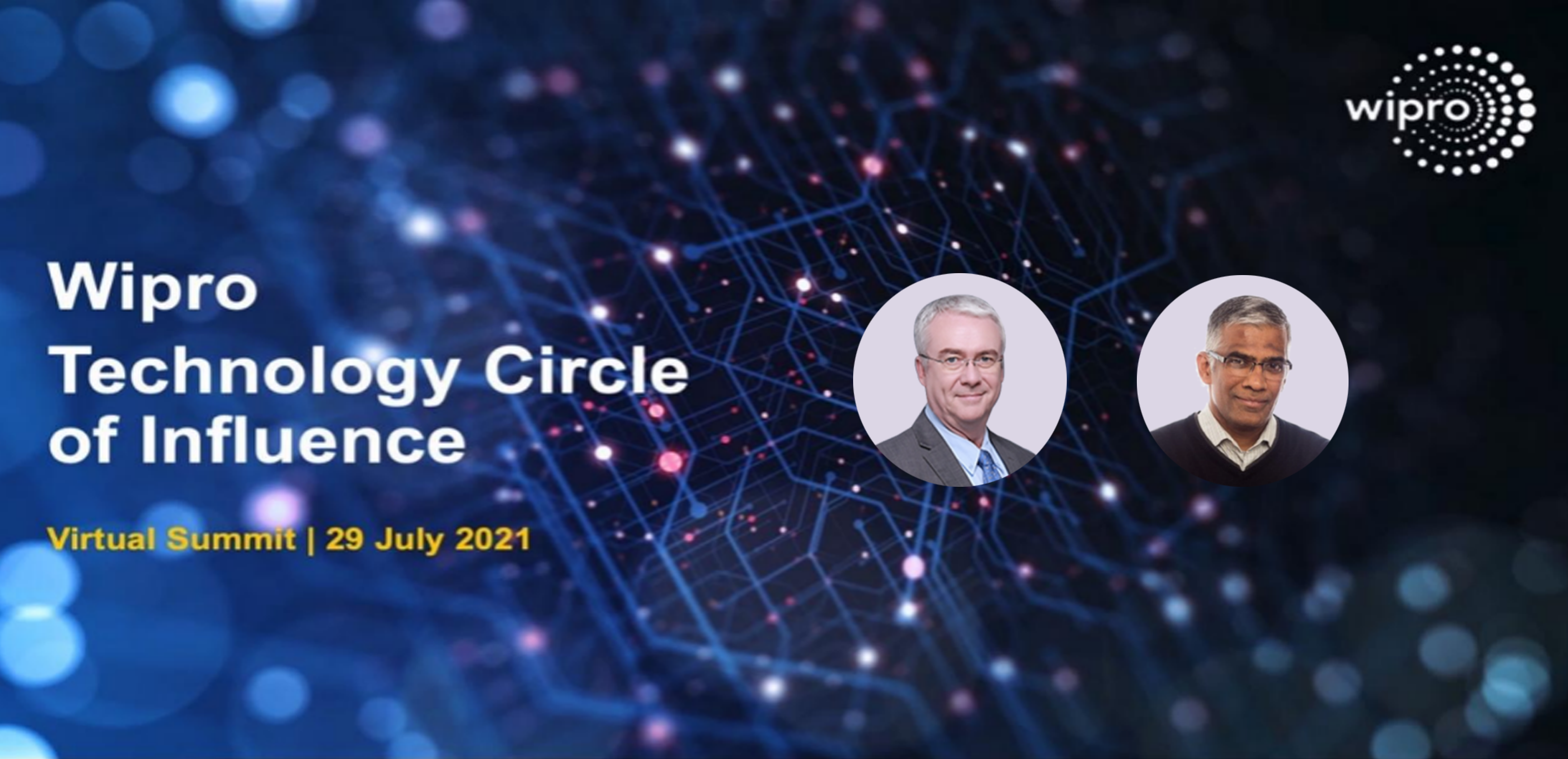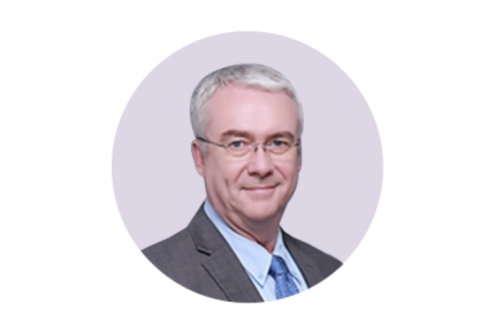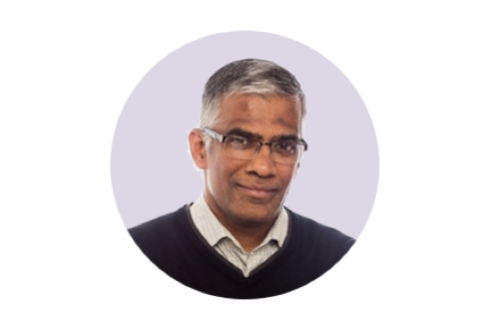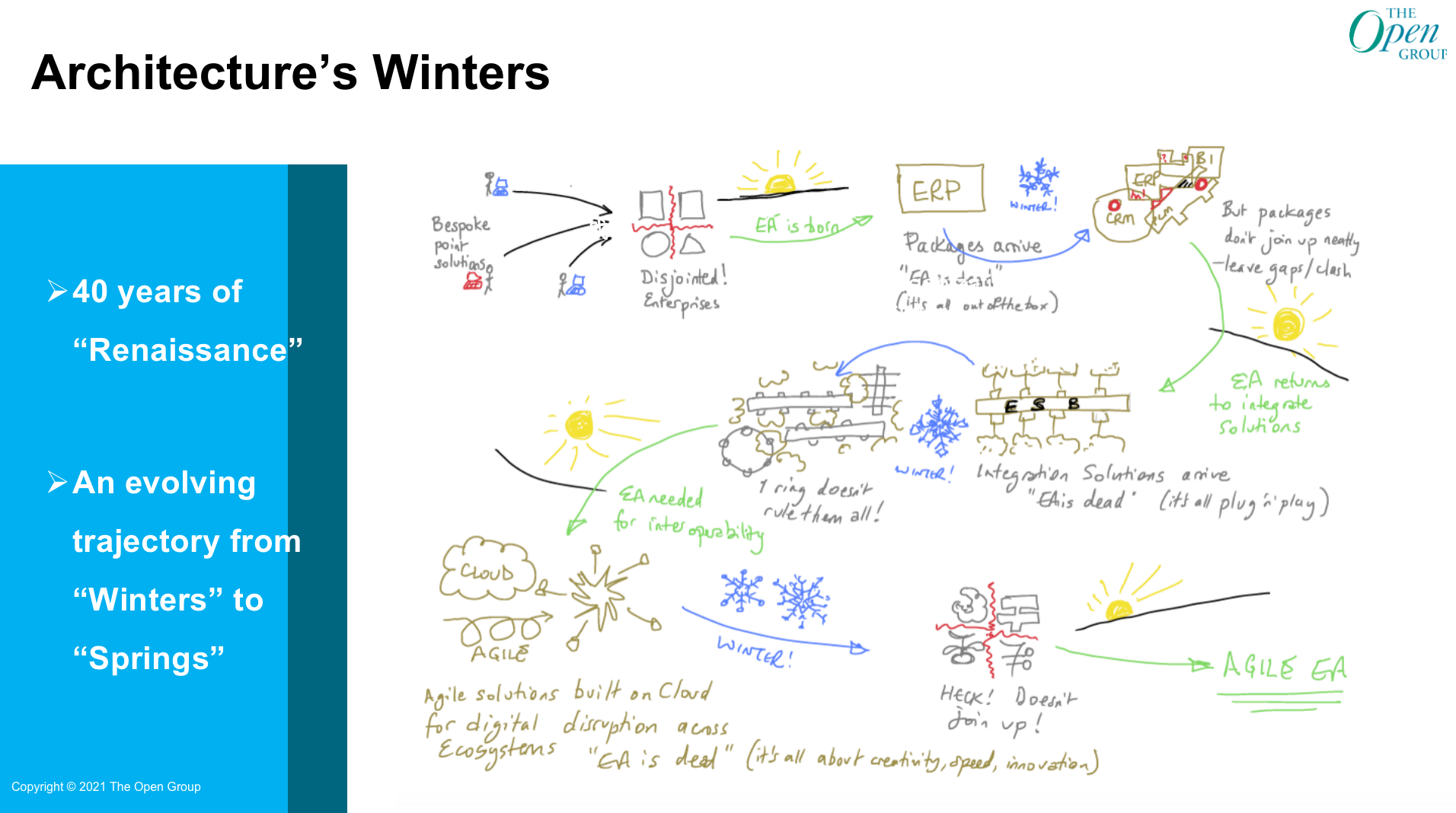【对话Chris Forde】受邀出席Wipro高层对话:数字时代企业架构师的未来

2021年是数字转型计划加速的一年,倒逼组织的业务战略发生许多转变。企业架构师比以往任何时候都更面临在快速变化的业务环境中重新确认其价值、角色和体系结构的挑战。The Open Group全球EA副总裁兼亚太地区总经理、企业架构师协会(AEA)首席执行官Chris Forde先生应邀出席Wipro高层对话,深度探讨数字时代的企业架构师如何进行角色转换,帮助企业布局数字化转型之路。

Chris Forde
The Open Group全球EA副总裁兼亚太地区总经理
企业架构师协会(AEA)首席执行官
Chris Forde加入The Open Group之前曾在美国运通公司(American Express)担任战略和架构副总裁,带领信息技术团队开发客户服务能力。Chris兼任企业架构师协会(Association of Enterprise Architects)首席执行官,在企业架构领域有丰富的管理经验和专业知识。作为The Open Group架构论坛的成员代表及论坛Chair,他在2007-2009年为推动TOGAF®成功问世发挥了重要作用。

Kiran M.R.
Wipro副总裁、企业架构部门负责人
Kiran在全球IT领域拥有30年的丰富经验,包括精益管理、领导全球销售和交付,以及成功构建下一代数字基础设施服务生态系统。在加入Wipro前,他曾经担任恩索诺公司董事会顾问。
Chris Forde灼见采撷
To be effective in the current digital age you need to change behavior and upskill. That entails recognizing and demonstrating where you, your specialization, and practice add value.
◇ 实践企业架构可能是困扰企业的症候,也可能是指引方向的灯塔。通常每个人都在转型的船上,有些人在划桨,有些人是乘客,有些人在掌舵,有些人在坚持。
The architecture practice may be symptomatic of what ails the enterprise, or it could be a beacon of light leading the way, typically everyone is in the transformation boat together, some are rowing and some are passengers, some are navigating, and some are hanging on.
◇ 企业仅仅考虑搭建自己的平台是不够的,必须考虑其所处的生态系统。
Being a platform based Enterprise is essential but, your platform is not enough, you must consider your ecosystem.
◇ 在这个复杂的生态系统中,企业需要一个供应链视角来进行数字化产品的交付。
In this complex ecosystem platform world you need a supply chain view of digital product delivery.
数字时代企业架构的优先级
Chris Forde
2018年的一天,我在社交媒体上得知基于TOGAF®等经典参考架构的实践已经不再适配人工智能(AI)和机器学习时代的商业需求。就在同时,我坐在季度会议上听一个演讲报告,讲的正是全球领先投资服务商穆迪公司(Moody's)如何基于TOGAF参考架构搭建由商业驱动的企业架构,用于开发并提升其机器学习能力。尽管在TOGAF系列标准中没有就人工智能的针对性论述,但穆迪仍然选择采用开放标准进行业务创新。在数字时代,企业需要看清什么是发展的助推器、什么是前进的绊脚石。
One day in 2018, I learned on social media that the practice based on classic architecture references such as TOGAF no longer meets the business needs in the era of artificial intelligence (AI) and machine learning. At that moment, I was sitting at the quarterly meeting listening to a speech on how the world's leading investment service provider Moody's was undergoing a business driven, EA supported activity based on coincidentally TOGAF to develop and improve its machine learning capabilities. While you don’t see artificial intelligence in TOGAF series standards, but it doesn’t stop Moody's from choosing to adopt open standards for its business innovation. In the digital age, enterprises need to see what is the booster of development and what is the stumbling block to progress.
那么,在各行各业顺应数字化趋势深化业务转型的同时,个人和组织应该如何做好准备?企业架构应该有哪些更新的优先级和业务目标?首先一个落脚点是企业敏捷性(Enterprise Agility)。企业敏捷性是指让企业以敏捷的方式运作并快速创新。这里对敏捷性的内涵特征有一个简单明了的概况:机敏性(Alertness)、可访问性(Accessibility)、果断性(Decisiveness)、快速性(Swiftness)和灵活性(Flexibility)。在此我强调灵活性,企业需要根据业务和客户的实时需要,适当调整其运营模式。
So given the trends taking shape as organizations expand their business transformation efforts, how can individuals and organizations be prepared? What are the renewed priorities of enterprise architecture? Enterprise Agility, or enabling an enterprise to operate in an agile manner and innovate rapidly. Here’s a list of the characteristics of agility which is pretty clear and simple: Alertness, Accessibility, Decisiveness, Swiftness, Flexibility. I highlight Flexibility here to emphasize the needs to change your operational model, the needs of your business and customers.
请注意,这些特性适用于企业的所有方面,而不仅仅是软件开发或IT组织。来自The Open Group的O-AA®标准指出,企业的数字化转型和敏捷性在进行变革的组织中是不可分割的。这一观点的相关性已经在诸如Society Generale、Michelin、Fidelity、埃克森美孚、富达投资、米其林、Autodesk、雷神公司和Comcast等进行了实验、认证和实践。在探索开放标准及其参考架构的过程中,你可以了解更多路径和选项,及时发现问题,预先认识到组织和自身在转型时需要反复做出决定的转变场景。
Notice these characteristics apply to all aspects of your enterprise, not just your software development pipeline or the IT organizations. The O-AA Standard from The Open Group states that digital transformation and agility for an enterprise are inseparable in organizations undertaking change. The relevance of this viewpoint has been experimented with, compared, contrasted and confirmed and implemented (to one degree or another) in companies like Society Generale, Michelin, Fidelity, Exxon Mobile, Autodesk, Raytheon and Comcast as examples. In exploring open standards material you will find paths and options enumerated such as the transformation dimensions, questions that arise, and transformation scenarios that you as an Architect and your organization will need to decide on perhaps repeatedly.
Kiran M. R.
At the same time, enterprise architecture in the digital age needs to cope with changing trends and needs, and constantly extend and update its core capabilities, including coordinating end-to-end enterprise solutions in the case of complex technology; Streamline its architecture team; Develop user-friendly enterprise architecture tools to support dynamic integration within the enterprise system and visualization of business capabilities. In addition, technology debt, cost reduction and resilience remain the top themes related to enterprise architecture capabilities.
一个宏观的“供应链”视角
这些敏捷性特征对于企业转型来说是一个很好的参考,但是它的宏观坐标和商业目标是什么?在不同的情况下,一个组织的成长成熟度和复杂性需要不同类型和层次的结构设计。作为架构师,我们必须提供与这些级别相适应的决策指导和信息,同时还要注意帮助组织在不同增长级别之间移动。
So it’s great to aspire to those Agility characteristics but what is your macro situation? Situationally, different types and levels of process and structure are needed for different levels of an organizations growth maturity and complexity. As architects, we must navigate and provide guidance and information for decision making appropriate to those levels, and, also pay attention to helping organizations move between levels of growth.
因此,企业仅仅考虑搭建自己的平台是不够的,必须考虑其所处的生态系统。在市场终端,客户和潜在客户在他们的指尖就可以对产品进行实时选择和反馈。不论是个人还是企业用户端,这种转变趋势都在持续加速。如今,人们期望无论何时何地、以何种方式,都能通过服务流程的整合一键获得他们想要的服务。通常情况下,大多数公司不可能独揽所有这些需求。2021年埃森哲的一份洞察报告显示,77%的受访高管表示他们的技术架构对公司的整体成功至关重要或变得日益重要。在这个复杂的生态系统中,企业需要一个供应链视角来进行数字化产品的交付。
Being a platform based Enterprise is essential but, your platform is not enough, you must consider your ecosystem. The “market reality” is that for sometime Customers and Prospects have had real time choice and feedback mechanisms at their fingertips. That shift continues to accelerate, both in BtoC and BtoB side. People today EXPECT to engage with their friends or acquaintances or colleagues.They EXPECT services integration. They EXPECT what they want when they want it how they want it where they want it. Typically it is impossible for most companies to meet all these demands alone. In a 2021 Accenture Insights Report, 77% of executives surveyed indicate their technology architecture is critical to or becoming critical to the overall success of their organization. In this composed ecosystem platform world you need a supply chain view of digital product delivery.
敏捷数字转型的一个核心原则是从“外部”视角来确定客户想要什么以及他们想要怎样做,并调动业务和技术来满足这些需求。从根本上讲,这种以客户为中心的观点隐含着价值的良性循环,并且承认了一些市场现实。这是一个由客户和产品意识、最新的可用技术和数据驱动的认知图谱。典型的顾客观包括零售购物、旅行计划、食品配送、社交媒体等。而员工的观点可能是以矿山经理、药物研究科学家或气候或石油勘探科学家作为出发点。
A central tenet of agile digital transformation is taking an “out side in” view of determining what a customer wants and how they want to do it, and mobilizing the business and technology to meet those needs. Fundamentally there is a virtuous circle of value implicit in this customer focused viewpoint, and a recognition of some market realities. This a customer and product aware, software enabled and data driven circle, supported and enabled by the latest available technology. To spill it out, the typical customer view entails retail shopping, trip planning, food delivery, social media, among others. While the Employee view might be a Mine Manager, Drug Research Scientist, or Climate or Oil Exploration Scientist.
“转型”和“优化”需双管齐下
Chris Forde
对于企业来说,进行转型的同时需要优化。优化运营效率对于股东、纳税人和私人企业所有者来说意义重大。在正确的事情上有效地运作不仅有助当前的业务,也有可能为新的投资和增长领域打开一条融资之路。
Now the “flip side” of transformation is Optimization. Optimizing operating efficiency is pretty valuable bread and butter stuff to shareholders, tax paying citizens and owners of private companies. Operating effectively on the right things helps your current business and potentially opens a funding path to new investments and growth areas.
为什么要强调“同时”呢?这是因为在其所有专业领域,企业架构无论是在业务进展顺利还是不顺利的时候都是相关的。与此同时,在企业转型过程中,企业周遭环境和企业业务可能在不断演进。因此,架构是用来处理难题的,它是在同时做两件非常复杂的事情,即转型和优化,并通过简化它们来帮助企业走在聚焦于价值交付的正确路径上。
Why is this “at the same time” context important? It is because architecture, in all its specializations, is relevant both when business is going well and when it is not. Also the world and your current business likely does not stand still while you transform. So Architecture is about dealing with difficult problems, it is about driving value while doing two very difficult complex things at the same time, transforming and optimizing, by simplifying them, and helping to maintain focus on the path to value in the organization.
这张图描绘了企业架构在过去40年间从“冬天”到“春天”不断交替的发展轨迹。从上世纪80年代到现在,每一个“冬天”和“春天”都在很大程度上促进了这个行业的发展。随着技术和行业蝶变,我们将会看到更多的“冬天”。因此,企业架构师需要考虑的问题是:新技术将如何影响我的业务实践和体系结构?
Here is an illustration of an evolving trajectory from “Winters” to “Springs” of EA. Each winter and spring From the 80’s to present day has largely lead to growth in this profession. There are going to be more winters as we move forward. So the question is: how will new technology impact your business practice and architecture?

麦肯锡近期的一项调研将由国际企业架构师协会(AEA)出版,它提炼了数字化时代企业领导需要考虑的核心事项。其中,报告调研了是什么吸引了企业架构实践中的杰出人才?其中,激励人才排名第三位的因素,也是区分数字化领导和其他人的最大差距,就在于员工教育,突出了职业发展机会的重要性。这里提供了一个建议,即让那些具备与强大利益相关者进行互动所需技能的人进行指导。员工指导是企业今后要考虑的一个关键特征,也是对特定类型合作伙伴的期望。TOGAF最近的另一项调查,同样重点关注了数字化能力、敏捷实践和设计思维。其中一个关键是简化企业架构,使其更加一致、更可读、应用性更强。
A recent McKinsey survey, to be published by the International Association of Enterprise Architects (AEA), refines the core issues that business leaders need to consider in the digital age. On the question “what attracts exceptional talent in the EA Practice?” The third-highest ranked incentive and the biggest gap is education of staff, highlighting the importance of opportunities for professional development. Here’s a suggestion to put in place mentoring and coaching from those with strong stakeholder engagement skills. Mentoring and coaching is a key characteristic for later consideration, an expectation you have of certain types of partners. Here’s another our recent survey by TOGAF also focusing on the digital capabilities and agile practices and design thinking. One of the key is to simplify EA and make it more consistent, readable and usable.
企业架构师的破茧之路
Chris Forde
站在企业和自身的角度,企业架构师需要基于企业文化和自己的发展需求不断学习,不断进行调整和适应。
For your Enterprise and For Yourself as an Architect,you need continuous learning, adjustment and adaptation based on your enterprise culture and your own development.
在数字时代,企业领导者对其架构师作为数字化实践者的期望越来越高,即以技术作为推动因素,高速实现业务和运营模式的变革。这些期望越来越像是在呼唤超级英雄。事实上,“企业架构”的实践反映的是专长组合,而不是层次结构,这些专长共同组成一种与实践紧密结合的职业。知道谁在哪些领域有资格,以及如何让他们参与或获得推荐是架构师职业的一个特征。企业架构师想要在数字时代取得成效,就需要知道并证明自身的专长在什么地方可以实现价值,需要适时改变行为、不断提高技能。
Organizations considered digital leaders with intensifying expectations for their architects as Digital Practitioners, that is to deliver on business and operating Model changes with technology as an enabler, at pace. These expectations are starting to look like a call for a superhero. “Architecture” as currently done is really a set of specializations, not a hierarchy. These specializations constitute a profession, with related practices. Knowing who is qualified in what areas and how to engage them or obtain a referral is a characteristic of a profession. To quote Antonio Banderas’ character in the Steven Soderburgh movie “Haywire” “I prefer me doing my job better than somebody else doing my job.” To be effective in the current digital age you need to change behavior and upskill. That entails recognizing and demonstrating where you, your specialization, and practice add value.
Kiran M. R.
是的,成功的企业架构是集体的成功,而不是个人的英雄事迹。企业架构不是固定的功能组合,而是根据市场的矩阵需求不断更新的专长集合。
Yes, successful enterprise architecture is collective success, not individual heroic deeds. Enterprise architecture is not a fixed combination of functions, but a collection of expertise that is constantly updated according to the matrix needs of the market.
Chris Forde
因此,作为一名正在经历转型的架构师,你需要破除一些由来已久的陈词滥调,对局势及时判断并进行客观的评估,以了解自己和企业需要哪些架构实践、技能和经验。对架构师来说,转变视角和思维方式并不意味着完全改弦更张,而是要基于现实的真实情形实践企业架构。实践企业架构可能是困扰企业的症候,也可能是指引方向的灯塔。通常每个人都在转型的船上,有些人在划桨,有些人是乘客,有些人在掌舵,有些人在坚持。
Thus, as an architects going through the transformation, you need to cut through the myths, and cliches, make stark assessments to get to the reality of your architecture practice, knowledge, skills and experience, competencies required for your company and yourself. Shifting the perspectives and mindset doesn’t mean throwing the babies out of the bath water, but being real in term of practicing enterprise architecture. The architecture practice may be symptomatic of what ails the enterprise, or it could be a beacon of light leading the way, typically everyone is in the transformation boat together, some are rowing and some are passengers, some are navigating, and some are hanging on.
总结来说,作为企业架构师,即便你以价值交付为指导进行实践,并且在团队中拥有非凡的才能,同样可能面临巨大的外部竞争和压力。市场对人才的竞争是激烈的,因此架构师需要选择哪些能力需要在内部保持,哪些能力可以通过外包获取。放眼未来,企业架构师这一角色可能需要包含设计业务和运营模型的管理顾问所需的技能。针对这一点,O-AA标准中列举了如下技能:战略营销和营销研究、用户体验、设计思维、精益产品和流程开发、企业架构、组织社会学、软件架构等。
So wrapping up now. Even when you orienting your internal practice based on value delivery and have exceptional talent in the team you will be facing significant external competition and pressure. Competition for talent is fierce, as always a choice has to be made what capabilities to keep internal and what to externalize. The range of skills that may be considered part of the Enterprise Architect role today and moving forward includes the disciplines needed for management consultants who design business and operating models. The O-AA standard incorporates these disciplines including strategic marketing and marketing research, User Experience, Design thinking, Lean Product and Process Development, Enterprise Architecture, organizational sociology, Software architecture, among others.








